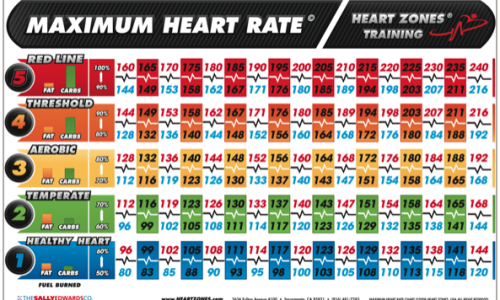There are two common ways to measure the individual Maximum Heart Rate, or MHR. One way is to estimate MHR in either an all out effort or with sub-max testing protocols. The second more erroneous way is to assess MHR for the individual by using one of the many formulas from population averages. Once the MHR is determined, that number in BPM can then be used as an anchor point or value to calculate individual heart rate training zones, which are typically marked in 10% intervals of the MHR number.
The Maximum Heart Rate chart shows five training zones each based on 10 per cent intervals of one’s individual MHR. First published in 1993, The Heart Rate Monitor Book 9, this chart removes all factors used in the earlier equations such as age or gender. By anchoring training zones on one’s actual individual MHR and setting goals based on percentages of a valid MHR number, a person or trainer can more accurately assess the appropriate amount of time to allot to each zone, arguably providing improved health and fitness benefits.
Why Do Some Individuals have a Higher MHR than Others of the Same Age?
Given identical age, fitness level, gender, and all other factors, how can non-smokers who are disease and medication-free individuals have as high as an 80 BPM difference in their tested MHRs. A perhaps whimsical answer lies in the differences between the heart rate of a hummingbird versus that of a blue whale.
First, let’s take the hummingbird’s heart beat frequency – more than 20 times each second – or as high as 1,260 beats per minute. A hummingbird’s heart is tiny, smaller than the size of an aspirin. Next, compare a hummingbird’s heart to the world’s largest heart – that of the seven-ton blue whale. A blue whale’s heart can be as big as a room. The cardiac frequency of hummers and whales varies from individual to individual just like humans, but in general, larger animals have a slower heart rate than smaller animals. The average heart rate of large whales is from about 10 BPM to a MHR of 30 BPM.
But, a more technical answer to the question why there is such an enormous range in MHR between two individuals of the same weight, size, and other factors has to do with heart mass. The bigger the dimensions, the size and weight of your heart, the lower your MHR – you are a blue whale. And conversely, the smaller your heart mass is as compared to your body size, the higher your MHR – you are a hummingbird
Adapted from Heart Zones white paper by Sally Edwards. Reprinted with permission.
Sally Edwards, MA, MBA, Physical Educator, is the CEO and founder of Heart Zones, Inc, the fitness technology company for Smart health and fitness. She is the author of 25 books on exercise, triathlon and running, and weight loss. She currently develops heart rate technology and programs for schools, health clubs, corporate wellness, sports teams, and rehabilitation centers.
References
Fox SM, III, Naughton JP, Haskell WL. Physical activity and the prevention of coronary heart disease. Ann Clin Res. 1971;3:404–432.
Robergs RA, Landwehr R. The surprising history of the “HRmax=220 minus age” equation. J Exerc Physiol online. 2002;5:1–10.
Nes BM1, Janszky I, Wisløff U, Støylen A, Karlsen T. Age-predicted maximal heart rate in healthy subjects: The HUNT fitness study.
Scand J Med Sci Sports. 2013 Dec;23(6):697-704. 2012 Feb 29.

